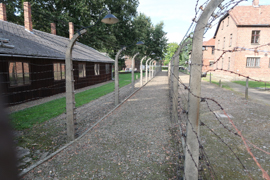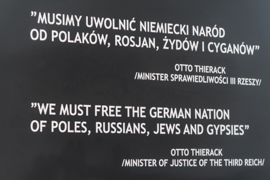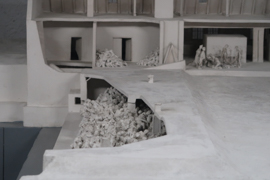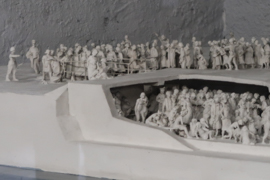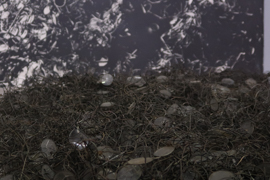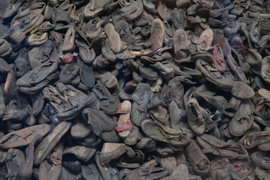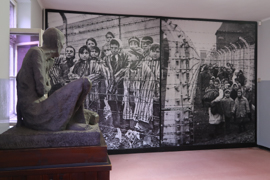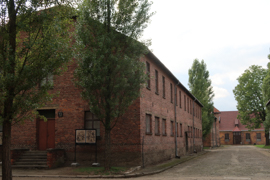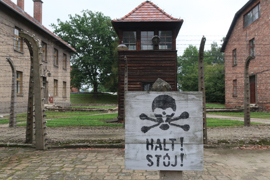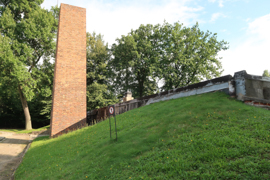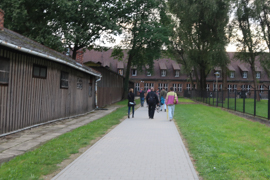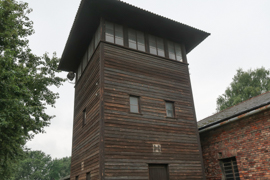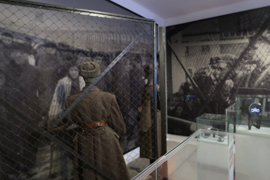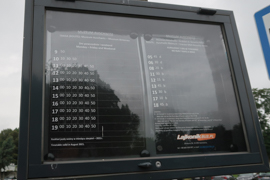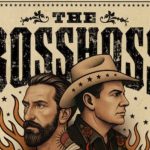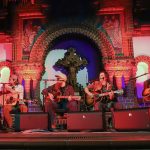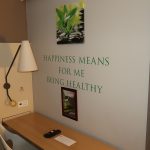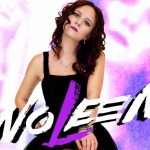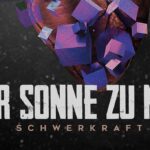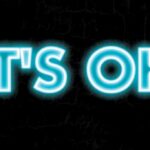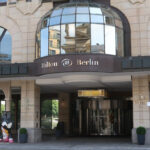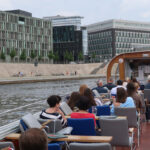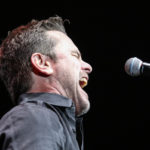Concentration Camp Auschwitz Museum
free entry / fee for guide
Flyctory.com Pros
- Impressive historic place
- Fantastic guide
- Free shuttle between Auschwitz and Birkenau
- Good headset system
Flyctory.com Cons
- Odd ticketing / entrance rules
Auschwitz is a town’s name (adopted to German) which you typically link with murder, cruelty, state-organized mass killings, injustice. A place which is unfortunately not unique in history, but definitely one of the most depressing ones. I have been to Oswiecim – that’s the Polish name of Auschwitz, a couple of years ago – but I felt, this place should definitely also be featured on Flyctory.com. Thus, I went back to Southern Poland in August 2021. Now, I am sharing my thoughts with you.







KZ Auschwitz Museum – Location & Admission
The former KZ (Konzentrationslager) Auschwitz is located in the Southwest of the Polish city of Oswiecim, which is roughly in the middle between Krakow and Katowice. I would typically recommend to go there by car (rental cars are cheap in Poland and driving is not that bad), but there are also organized tours or you catch a driver. Most of these tours start in Krakow, even though Katowice is slightly closer. There is free parking in front of the museum, but space is rather limited. If you do not visit Auschwitz at a very early time, you will likely end up in one of the moderately priced parking lots around.
The Auschwitz-Birkenau Memorial and Museum features both places, Auschwitz and the Museum and the Auschwitz-Birkenau Extermination Camp (separate posting, see link). Their opening times differs by month, also due to the lack of artificial light, especially in Birkenau. Between June and August (when I visited the place), there are the longest opening times, 8:00 to 19:00 hrs. In December, the museum already closes at 14:00 hrs. You may always stay up to 90 minutes longer than this last admission time.




Admission & Guides
Admission to Auschwitz and Birkenau is generally free. However, the majority of the day is blocked for visitors of guided tours, the guides are arranged by the museum. During my visit, the earliest possible time slot for a non-guided tour free ticket / reservation was 16.00 hrs. Thus, time is limited. The museum suggests to have 90 minutes at each place, I would rather go for two hours in Auschwitz, plus the bus transfer. Guided tours are available in multiple languages, from 2.5 hrs (too short in my point of view) to 3.5 hrs to a six hour study day. Pricing for the guide is generally moderate, but differs by duration of your tour. You may also hire a private guide.
In general, I would recommend to book Auschwitz tickets early, weeks or better months ahead. They sell out quickly. Guides in Auschwitz work with an audio system, so that you can listen to them (even over quite large distances) during your visit by headphone (technology is provided).


KZ Auschwitz Museum – The Visit
The tour starts at the main gate with the famous Arbeit macht frei (“Work is freeing”) words above. Our guide Patrycja was amazing and told us about the camp in very impressive words. The first camp (so: this place) was really thought to be a prison, a concentration camp, where you gather your prisoners and enemies. They may die there due to starvation and other reasons. It has been chosen as there has been a Polish military barrack before. The structure was also not planned – the Nazis just what was there. In contrast to that, Auschwitz-Birkenau was an extermination camp, majorly designed for killing people and built from scratch (this explains why the rails enter the camp and why the route from the trains to the gas chambers is relatively short).








Museum about Auschwitz and Birkenau Cruelties
The Auschwitz Museum does of course illustrate what was happening that place, but also illustrates the cruelties in Auschwitz-Birkenau. For example you learn about the routes on which the the over one million victims have been transported to Auschwitz. You also learn about the selection of people (which just means: selecting the people who are sent into the gas immediately) and get to learn how the gas chamber system did work. You even find old Zyklon B capsules, the biocide which turned into poisonous gas at some 28 degrees.















Sample Belongings of Victims
The most impressive part of the exhibition to me are the former belongings of Auschwitz victims. The most famous part are likely the cut-off hair (majorly female hair, which has then be processed into different products) – this is one of the rare places in which the museum does not allow you to take pictures. A very impressive part is the huge collection of shoes. But there are also glasses, prothesis or suitcases, which even had the name of the people on it. They were told that Birkenau will be their new home – a majority of them lived there just a few hours.




















Life at Auschwitz
A very important part of this museum is of course to tell how the prisoners lived in the concentration camp Auschwitz. For example, the guide told us that they had to sleep on one side to safe space. Diarrhea was rather common as well as other infections and illnesses. The prisoners however knew that if they were regarded to be ill, they would likely be killed. Block 11 is the block, where trials again Oswiecim locals have been performed (with hardly any chance to defend yourself) and people have been shot and hanged. The prison cells in the basement were closed due to Covid-19. Photography there is not allowed, as it was nothing but torture and a preparation to be murdered.




















Other parts of the visit are the “hospital” (where ill people were typically killed by a lethal injection into the heart and the square where prisoners were counted to ensure nobody fled. The Auschwitz Orchestra shows how well these places were organized: prisoners had to play marches so that prisoners had to walk along in the rhythm of the music. The only rationale for that was that it was easier to count them in rows of five.










The Gas Chamber
The KZ Auschwitz also had a gas chamber – however, the capacity was rather small and too low. Nonetheless, you can walk through the gas chamber and also see the ovens. In front of that place, there is the gallows at which the former lead of the camp, Rudolf Höß, has been hanged after WW2.



















Special Exhibits
There are temporary and special exhibits. These are not part of the 2.5 / 3.5 hour tours. For example, I visited the afternoon before my tour the exhibition block about Russians in Auschwitz (randomly, could have been any other place). I felt that the stuff there was really interesting – the more I would recommend to go for them. More details how I would suggest to spend a day in Oswiecim are in the Auschwitz-Birkenau posting.






KZ Auschwitz Museum – Services
Surprisingly, the list of services at the museum entrance is rather small. There is a snack bar, a small book store, a post office and a money exchange.

After you visited Auschwitz, the second part of your tour heads towards Auschwitz-Birkenau. Buses left every ten minutes during my visit. The transfer is free.I would definitely recommend to go for the bus rather than using the (only one) parking lot at in Brzezinka.



KZ Auschwitz Museum – My View
The visit to Auschwitz was amazing. One huge factor for that was the impressive Patrycja, who did an awesome job explaining the cruelties, but also the “management” of the two cruel places. The organization with the headset is perfect. If you can stand this place mentally, I absolutely recommend to go there. It is one of the most impressive (and most saddening) places I have ever been to.
Nazi Germany Memorials
Here are all places memorizing about the cruelties during the German Nazi leadership:

The former concentration camp site at Bergen-Belsen might not be as prominent as Dachau, but it is nonetheless one of ...

The Museum of Jewish Heritage in New York City also calls itself A Living Memorial to the Holocaust. Even though I ...

During the Nazi regency in Germany, the Emslandlager (Emsland Camps) was a group of concentration and detention camps in the Emsland region, ...

It is time for the final posting of the years, simply named The Best Ones 2021. After looking into my ...

The same faith which applies to Oswiecim in Poland (better known under the former German name Auschwitz) is also valid, ...

A very interesting rebranding: when I started to explore museums in the nearby Netherlands, the Dutch Freedom Museum in Groesbeek ...

It is almost needless to say that Adolf Hitler was obsessed with megalomanic ideas. Apart from ruling the world and ...

The National Monument Camp Vught - or Konzentrationslager Herzogenbusch, which has been the German name during the Nazi era - is ...

Even though the Netherlands capitulated against Germany just after a few days under attack during World War II, they have ...

Nuremberg (or Nürnberg, how it is named in German) has some sort of tough political-historic heritage. Several sites still remember ...

The Weiße Rose / "White Rose" was a resistance group during the German Nazi regime. Mainly consisting of university students, she ...

The Berchtesgadener Land is not only nowadays well-known as a popular tourist destination, there is also a dark part of ...

Nuremberg is deeply linked to the German Nazi regime between 1933 and 1945. The key reason for that are of ...

Especially in the recent past, I read a couple of ridiculous comparisons between certain people and political groups (which I ...

When you think about Nazi Germany murders, you typically think of extermination camps like Auschwitz or the concentrations camps. A ...

Braunau am Inn - the small town right at the Austrian-German border is indeed a picturesque place and a nice ...

On 21st October 1941, the German Wehrmacht slaughtered thousands of civilians in Kragujevac, Serbia, to revenge dead and wounded soldiers ...

The Royal Ontario Museum just feels like an amazing wonderland of topics, a bit of "something for everyone". Did you ...
Flyctory.com in Berlin
Here are all postings related to the German capital:

Feels like the year 2025 is slowly coming to an end. While there are quite a lot of Best of and extended releases, ...

The Waltons call their music cow-punk and mix country and punk elements in their music. This is a quite successful ...

According to the duo's Bandcamp site, their music is coming straight from their HQ - a cozy kitchen in Berlin-Kreuzberg. With Ready ...

I am still on the Faroe Islands, briefly before I am about to leave my favorite islands. There is also ...

Late summer 2025 was somehow The BossHoss time on Flyctory.com. After having a great and intense interview with Sascha Hoss Power Vollmer ...

I already chatted with Sascha Hoss Power Vollmer about Back To The Boots in my recent Spotlight interview. Now, it is time to share ...

My weekend this time will be under full control by the Sound of Nashville Open Air 2025 in Cologne. Three ...

You simply cannot say that modern country music and country rock in Germany is a success story. However, there is ...

Summer time in Germany - as the 16 German states have individual summer school break periods, this is the only ...

I am at a company event in Bremen the whole weekend. Thus, I had to prepare quite a lot of ...

I try to increase my volume on pure blogging posts, in which I give my personal opinion on certain topics ...

As I am majorly busy - and exhausted - from my Six US States and Nashville trip, I am rather thankful ...

I am just sitting at the American Express Centurion Lounge in Heathrow (LHR), ready to head to the United States ...

I really love Eggs Benedict. It is one of my favorite posh ways of having breakfast. How could I neglect ...

The Charité is one of the most famous and best hospitals in Germany. It is driven by the two key Berlin universities, ...

The 2025 Country To Country in Berlin took quite a lot of energy from me. On top of that, there ...

Country To Country 2025 in Berlin is in the books. Three days and the kick-off Bluebird Cafe session are over ...

Country To Country 2025 in Germany came to an end. The Sunday Main Stage (and the Spotlight Stage) hosted the ...

Three days of country music (or even four, if you include the Bluebird Cafe session on Thursday) are tiring and ...

The second day in Berlin was slowly coming to an end. Country To Country 2025 in Berlin hosted the second ...

Saturday in Berlin - the Country To Country festival went into its second day. 8th March 2025 again featured some ...

Welcome to the main event! While I really enjoy the daytime stages with the variety of comparably less popular artists, ...

Ladys and Gentlemen, welcome to the Country To Country 2025 in Berlin! After the Passionskirche in Berlin already hosted the ...

My weekend this week is dominated by the Country To Country Festival 2025 in Berlin. My report of the kick-off ...

6th March 2025 was time to kick off the Country To Country Festival 2025 in Berlin. While the main festival ...

The Wellerman gave fame to two bands almost in parallel in the early 2020's. While I already featured the Cologne show of ...

In exactly two weeks, on 6th March 2025, Country To Country (C2C) Berlin is kicking off with the The Bluebird ...

I had a quite frustrating week. My accreditation requests for four photography events, three sports reports an one concert, have ...

I recently forgot a name of a German country artist and had to google it. I started typically by looking ...

I'm in Finland this week, featuring two floorball match. However, the Nordic country is not represented in my Songs of the ...

Ladies and gentlemen (and all the others of course as well), we got it: here is my first Songs of the ...

Are you already counting down the days to Christmas? You definitely feel an impact on the music industry of the ...

Just two months until Christmas. Times are getting colder (at least on the Northern hemisphere), people spend more time inside ...

As I didn't feel like taking the night ICE train after my August 2024 trip to Dresden from Berlin to ...

Hungary this weekend! After my trip to Indonesia, I am back in Hungary after such a long time of absence ...

I really enjoy riding the Railjet. The type of trains is majorly the backbone of the Austrian high-speed rail network ...

I am currently on my first trip ever to the Southern Hemisphere. As expected, the German music market on 4th ...

I loved Bell Book & Candle in the late 1990's. The German band from Berlin especially stroke with their debut ...

I had a very tough business trip to Paris this week. Nonetheless, I somehow managed to compile this list of ...

Another year, another time for Rock of Ages. Similar to the previous years, I disclose some of the international dates I ...

My Songs of the Week fascinate me not too rarely by myself. I collect potential candidates for the playlist and release ...

Medieval music, metal style - the German band In Extremo is really successful with this rather rare blending of genres ...

This edition of my Songs of the Week feels like a ballad edition. There are a lot of gentle and emotional song ...

Summer vacation season in Germany, national holiday in Switzerland - the music industry obviously felt (or was right) that this ...

What a week - I returned from my tennis coverage in Newport, now I am at the Olympic Games in ...

My bags and cameras are packed, I am ready to head to Newport for the Infosys Tennis Hall of Fame ...

The press kit to the debut album Integration describes the music of Command0 as an exploration of spacey synths, big beats and ...

The history of Berlin nowadays is also a story of two airports which have been closed down in the meantime ...

For the second part of my "review battle" of museums dealing with visions around the future, we leave the Museum ...

The German band Brokof is active since 2007. They established in the German music scene and already released five studio ...

A lot of traveling is ahead of me. I just returned from a trip to Bochum, watching my first two ...

Germany is sunk in strikes of different kinds, mainly in transportation business. I have been impacted this week by that ...

I struggled a bit compiling the Songs of the Week this time. The partial flight miles for my current trip ...

February 2024 is quite an intense month for me. Even though the trips I have planned and done are comparably ...

Coming back from the United Arab Emirates and about to head to Malaysia soon - thus, some really interesting experiences ...

January 2024 has already passed and we are running into the first February 2024 edition of my weekly release radar ...

In the relations of my home town Cologne, we are celebrating a big Songs of the Week anniversary with this edition. My ...

After I gave you my report of the field and side events of the 2004 Sparkassen Indoor Meeting in Dortmund, ...

Seeing one of the very first appearances of the Faroe Islands at a EHF Euro in handball just felt too ...

Typically, there are two sorts of album reviews at Flyctory.com: I received the vast majority of reviews as a promo ...

A big name in the schlager business: 41 years after Andreas Martin releases his very first studio album, he is ...

Unfortunately, I could not complete the Country Christmas Playlist this year due to technical issues. However, since the days become ...

TraMy trip in late October / early November 2023 involved a lot of traveling. Once I made it back to ...

Halloween is not that much of a big deal in Germany - but some parts of my home country have ...

Just about a month after I saw Randall King at the Cologne Club Volta, I was back there again on ...

At the end of September, some miraculous things were happening on the Instagram accounts of the Country To Country Festivals ...

There is somehow always some sort of "topic" behind each and every Songs of the Week episode. If I would pick one ...

It is just mid-year 2023 and I already start working on my 2024 Rock of Ages International Tour list. I am sure ...

September 2023 will be a quite busy monh. If I finally receive all press passes I envisage to get, there ...

I am still relaxing from all the trips I had during the last weeks. Nonetheless, things are just busy and ...

I am surprised that it has never been there before, stated Jackson Dean, one of the four artists, who will ...

After some rather intense week of traveling, I feel rather happy to spend the next two weekends in and around ...

My first posting from the Manforter Stadion at the #TrueAthletes Classics 2023 in Leverkusen has been about the field events. Now, ...

With this fourth posting, I am closing my coverage of the German Athletics Nationals 2023. The Auestadion in Kassel hosted ...

I am a huge fan of the field events in athletics - and thus, I am really glad to also ...

The German Athletics Nationals (or German Athletics Championships... or Deutsche Leichtathletik-Meisterschaften) 2023 in Kassel were truly one of the events I ...

Motorbikes and good music - I am having a really good time in Pfullendorf at the Lake Constance region in ...

I typically rather focus presenting new and emerging act in my Song of the Week, but this time, the list of ...

I received so many great albums this week - no chance to process a fair fraction of them. However, the ...

Sad and touching moments just need to have a good hotel stay for your soul. For the very last leg ...

It is already the second time, the Germany-based, but international folk duo Flora Falls is releasing a major set of ...

After the volume of songs in the last two weeks has been rather thin, this week's Songs of the Week comes with ...

As I told you in previous postings, I initially gather candidates for my Songs of the Week, before I narrow the ...

As I am having some quite intense travels ahead of me, I currently try to prepare as much contents for ...

Pop, rock, schlager and much more - I feel that this week's Songs of the Week is a really nice mix of ...

I have to give in: the song leading this week's Songs of the Week might also be a candidate for the ...

I am always impressed where the Songs of the Week each weekend finally end of. This time, for example, i have been ...

Sometimes, it is easy to select the leading track of my Songs of the Week: I had two hot candidates, but ...

Ten shows within three weeks - I was just so flattered to welcome Weird Al Yankovic and his lovely band ...

After my most recent edition of my Songs of the Week majorly featured German artists and a lot of pop, my song ...

I love gathering songs for Songs of the Week, as the result is so unpredictable, even for me, until short before ...

I was quite surprised when I received the press kit for Antonia Kubas' debut EP: Liebe und Musik ("Love and music") ...

Medieval hard rock, Gothic, dance music? Tanzwut is definitely one of these bands in the German music scene, which are ...

I am kicking off the most stressful part of the year, quite likely. This week, I headed off to Peterborough ...

What a day - on 14th January 2023, I traveled through all 16 German states in a 24 hour train ...

AIthough has just been a day trip, but I just felt it is too long to tell the story of ...

Okay, I give in: this trip is weird. While people typically feel that I am "just" a die hard aviation ...

Wow, that's massive! After I had a quite thin list of new releases since mid-December 2022, Christmas break is officially ...

Especially when I wrote my Best Ones 2022 posting recently, I absolutely felt that I should increase the coverage of sports events ...

Welcome to the first Songs of the Week posting in 2023! Despite the music industry is slowly getting back to business, I ...

The Pergamonmuseum is one of the key touristic places in Berlin. The museum features over 250,000 objects of German-lead excavations ...

I was quite amazed that there were quite a lot of interesting single releases this week. At least artists from ...

Nina Hagen is one of the most iconic entertainers in the German cultural scene. The German "Godmother of Punk" wrote ...

A lot of Christmas songs, a lot of covers and best of albums are the new releases in the - ...

Very interesting weekend this time: with the shows of Milky Chance and Brett Young, both in Cologne, I had quite ...

After two intercontinental trips in October 2022, I am somehow glad that I am scheduled to stay in Europe until ...

Freddie! Who would have thought that Mr Mercury is part of my Songs Of The Week one day. Not sure if Bryan ...

I typically rather sort out new albums by the sound than by the popularity of the artists. Thus, I am ...

"One man, one camera, one guitar" - that's about the idea of the current mission of Jim Kroft. The Berlin ...

After I gave you an overview of 2022 European appearances of my favorite musical Rock of Ages, I felt to ...

I typically just select the song, which is leading my Songs of the Week. This week, my favorites of the week ...

Rock and harder rock styles have been a bit of under-represented in here the last weeks. The more I am ...

Weird times: my list of candidates for my Songs of the Week this time was much longer, but a lot of ...

Typically, I first collect tracks for my Songs Of The Week and, once the set is complete, pick my favorite and ...

Survive is the debut EP by a Berlin-based project, Confirmation. I got in touch with their music and felt to share ...

Whenever I start working for my Songs of the Week, I typically scan the candidates I archived for that reason and ...

The press kit to Brain Freeze, the second EP by Leepa, states that the German is maybe the most promising talent ...

A museum full of computer games and gaming history? The German capital can offer that one! Right in the city ...

Due to illness, I unfortunately cannot provide you the full coverage on the music side of Flyctory.com - and it ...

While I had to process quite a lot of country music new releases this week, the list of non-country songs ...

Debut EP release: German-Iranian artist Mina Richman releases her first five song set on 6th May 2022. The EP is ...

Oh, I feel that the Songs Of The Week are really a tradition on Flyctory.com now. More than three months since I ...

After the end of World War II, the blocking of access to West Berlin by the Soviet Union (the so-called Berlin ...

The name of the German band Der Sonne zu Nah roughly translates to "Too close to the sun". In fact, ...

As I have been in Berlin but could not and did not really want to do a full coverage of ...

Britpop / Britrock made in Germany - that's a likely the best short description you can do about the Berlin ...

Hauptstadt der Spione - "Capital of the Spies". This is a book, which you can buy at the souvenir store of ...

Yes, I do like flying - but I am also a fan of rail travels. Just to find out how ...

It is time for the final posting of the years, simply named The Best Ones 2021. After looking into my ...

The Tränenpalast ("Palace of Tears") in Berlin is the former border crossing point between East and West Berlin. It is located at ...

In early November 2021, I received a promo EP from a folk music duo from Berlin, Flora Falls. A bit ...

In July 2021, I wanted to explore some of the rather centrally located attractions of Berlin. Due to its good ...

Madame Tussauds is a global franchise - not too surprisingly, they also have an outlet in the German capital, Berlin ...

He does it again: after he successful of three 1990's pop tracks, transformed into orchestral arrangements, Alex Christensen is back ...

What is happening if you are running and airport and you just don't fine an airline which is motivated to ...

Doing a cruise on Berlin's key river Spree is one of the classic touristic options when you visit the German ...

Driving a model landscape or a large model train landscape in Germany is a difficult business: Even if you do ...

Andreas Dorau everywhere: just two weeks after I reviewed GschichterIn aus dem Park Cafe, the new album by Die Liga der ...

It is almost needless to say that Adolf Hitler was obsessed with megalomanic ideas. Apart from ruling the world and ...

I started to enjoy the pop-Northern Soul style of the German band Die Liga der gewöhnlichen Gentlemen, when the recorded ...

Have you ever heard of Surströmming, Hakarl or Spam? Do you mind eating eyes or drinking cow blood? All these ...

If you know the name Carlo Pedersoli by heart, then you are likely ready to head to Berlin since 27th ...

I ran into Orian and his music by scanning new releases on a promotion platform. I just loved the special ...

During my recent daytrip to Berlin, I took the opportunity to have a walk through sunny - and empty - ...

Historic panoramic painting fascinated me massively the last months. I already introduced you to the Panorama Mesdag in The Hague ...

Indigo by Noah Levi is another publication with talent show background: in young teenage years, Noah Levi became famous by ...

From a school band to a flat share and finally their debut album - this is a very short wrap-up ...

The promotion kit of People Club calls the act an indie-lo-fi-slacker band. Ooops, I have to admit that I would ...

The fourth album by the multi-national project Mighty Oaks on 7th May 2021: boosted by lead singer Ian Hopper in ...

I originally planned a flight to the new Berlin Brandenburg Airport in late October 2020. Due to all the pandemic ...

When I listened to Robert John Hope's solo album debut Plasticine Heart, I felt that I should definitely share these ...

More than thirty years ago, Diane Weigmann was part of the founding of a legendary German band, the Lemonbabies. She ...

In April 2021, I finally had my first flight connections to/from the new Berlin airport, BER - Berlin / Brandenburg ...

The band which is featured in this review is called Löwen am Nordpol - "Lions at the North Pole". Apart ...

Indeed, Hanna Batka is Mitten in Berlin - "In The Middle of Berlin". She is not only indeed living in the ...

Alphaville, Ultravox and Mike & The Mechanics on one album? Okay, I have to give in that neither of the ...

Fourteen years after their latest album, the German project X-Perience is releasing a new album. The fifth long-play release of ...

During my Covid-19 day trip to Berlin, I spent some time in the Berlin Zoo. Berlin is quite famous for ...

Coming back from London from the (finally cancelled) Country To Country Festival 2020 was the last trip I took before ...

Due to the late cancellation of the C2C festivals in London, Dublin and Glasgow and all the organizational trouble caused ...

The last four big acts of the C2C Country To Country in Berlin 2020 - the three days have been ...

My third and final issue of stories around the C2C in Berlin - time to finish the days of country ...

Sunday, 8th March 2020, the third day in Berlin. Already that typical mixture of feelings: looking forward to the last ...

After a good start on Main Stage on Day 1 with Luke Combs, Jimmie Allen and Darius Rucker headlined the ...

After the the first side stage acts on Day 1 of the C2C Country To Country 2020 in Berlin, Day ...

Saturday in Berlin is over. A lot of good music has been played on several stages - but some stories ...

Time for the big party - after the side stage artists of Day 1 have cheered up the audience, it ...

C2C Country To Country in Berlin 2020 - time to start the second edition of the festival on 6th March ...

The German Country Music Scene is having their highest holidays - The C2C in Berlin started on 6th March 2020 ...

A lot has happened since the Country 2 Country 2020 headliners for all five venues have been published in October 2019 ...

Bad times of terror, being pried and controlled in a country without the freedom to move - or good times ...

During our visit of the Country 2 Country 2019 in Berlin, we chose the Hampton by Hilton Berlin East Side ...

I visited Europe's biggest country music festival, Country 2 Country (C2C), for the first time in 2018 in London. I immediately ...

Kiddo Kat already a viral hit on Youtube in 2016. Now, Anna Guder produced her first album "Piece of Cake" ...

More than 1,100 rooms in the German capital - the Estrel Hotel in Germany's capital Berlin is just a massive ...












